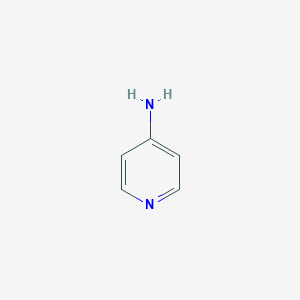Details of the Active Pharmaceutical Ingredient (API)
| General Information of API (ID: D00001) | |||||
|---|---|---|---|---|---|
| Name |
Dalfampridine
|
||||
| Synonyms |
Click to Show/Hide the Synonyms of This API
4-aminopyridine; 504-24-5; pyridin-4-amine; Fampridine; 4-Pyridinamine; Dalfampridine; 4-Pyridylamine; p-Aminopyridine; Avitrol; gamma-Aminopyridine; Ampyra; Avitrol 200; Pyridine, 4-amino-; Amino-4 pyridine; Pimadin (free base); Compound 1861; Phillips 1861; FAMPYRA; Neurelan; Prc 1237; VMI 10-3; C5H6N2; 4-amino-pyridine; UNII-BH3B64OKL9; 4- Aminopyridine; pyridin-4-ylamine; EL-970; NSC 15041; .gamma.-Aminopyridine; 4-AMINOPYRDINE; N07XX07; 4-Aminopyridine, 98%; MFCD00006439; BH3B64OKL9; MLS000069400; CHEMBL284348; Dalfampridine (4-aminopyridine); CHEBI:34385; NSC-15041; NCGC00015009-08; SMR000058211; 4 Aminopyridine; Fampridine-SR; DSSTox_CID_3870; DSSTox_RID_77212; DSSTox_GSID_23870; Caswell No. 038; VMI-103; Mi-W-3; CAS-504-24-5; Ampyra (TN); HSDB 6037; VMI 103; SR-01000075299; EINECS 207-987-9; RCRA waste no. P008; EPA Pesticide Chemical Code 069201; Dalfampridine [USAN:INN]; BRN 0105782; fampridina; fampridinum; Frampridine; Ampydin; BIIB041; Pymadin; AI3-52547; BIIB 041; Fampridine-PR; Dalfampridine-ER; 4-pyridyl amine; para-aminopyridine; 4-amino pyridine; pyridine-4-amine; Neurelan (TN); pyridine-4-ylamine; Fampridine [INN]; Fampyra (TN); pyridin-4-yl-amine; 4-Aminopyridine 10; PubChem1281; Philips 1861; Dalfampridine (USAN); Spectrum_000155; Tocris-0940; Fampridine (JAN/INN); PYRIDINE,4-AMINO; Opera_ID_1768; Spectrum2_001413; Spectrum3_000914; Spectrum4_001013; Spectrum5_001501; Lopac-A-0152; UPCMLD-DP125; WLN: T6NJ DZ; 4-Aminopyridine (4-AP); 4-Aminopyridine, >=99%; Lopac0_000032; BSPBio_001562; KBioGR_000282; KBioGR_001505; KBioSS_000282; KBioSS_000635; 4-imino-1,4-dihydropyridine; 5-22-09-00106 (Beilstein Handbook Reference); ARONIS25052; DivK1c_000572; SPECTRUM1501130; SPBio_001486; BIIB-041; GTPL2416; CL-COB-III-274-1; DTXSID0023870; UPCMLD-DP125:001; AMPD00207; BDBM10458; HMS501M14; KBio1_000572; KBio2_000282; KBio2_000635; KBio2_002850; KBio2_003203; KBio2_005418; KBio2_005771; KBio3_000563; KBio3_000564; KBio3_001888; NINDS_000572; Bio1_000353; Bio1_000842; Bio1_001331; Bio2_000282; Bio2_000762; HMS1361O04; HMS1791O04; HMS1921H15; HMS1989O04; HMS2092F05; HMS2234N24; HMS3260G05; HMS3267E21; HMS3370J03; HMS3402O04; HMS3414H15; HMS3678H13; HMS3886I09; KUC111877N; Pharmakon1600-01501130; ZINC599985; ACT05167; HY-B0604; NSC15041; VMI-10-3; Tox21_110065; Tox21_200793; Tox21_500032; ANW-75388; BBL009925; CCG-39031; HTS004685; NSC757845; RB8003; RW2023; SBB004393; STK298717; AKOS000119896; Tox21_110065_1; BS-3729; DB06637; LP00032; LS20499; MCULE-6604546217; NSC-757845; QC-4324; SDCCGMLS-0066228.P001; SDCCGSBI-0050021.P004; VP10051; IDI1_000572; IDI1_034032; p-Aminopyridine [UN2671] [Poison]; NCGC00015009-01; NCGC00015009-02; NCGC00015009-03; NCGC00015009-04; NCGC00015009-05; NCGC00015009-06; NCGC00015009-07; NCGC00015009-09; NCGC00015009-10; NCGC00015009-11; NCGC00015009-12; NCGC00015009-13; NCGC00015009-14; NCGC00015009-16; NCGC00015009-23; NCGC00015009-24; NCGC00024890-01; NCGC00024890-02; NCGC00024890-03; NCGC00024890-04; NCGC00024890-05; NCGC00024890-06; NCGC00024890-07; NCGC00024890-08; NCGC00024890-09; NCGC00024890-10; NCGC00258347-01; NCGC00260717-01; BP-21343; SBI-0050021.P003; DB-028705; AM20061261; EU-0100032; FT-0665455; ST45053817; AZ0001-0464; A 0152; C13728; D04127; M-6065; 68146-EP2269990A1; 68146-EP2284157A1; 68146-EP2289894A2; 68146-EP2298731A1; 68146-EP2308874A1; 68146-EP2380872A1; 79676-EP2305695A2; 79676-EP2305696A2; 79676-EP2305697A2; 79676-EP2305698A2; AB00052209_12; [J.Pharmacol.Exp.Ther. 275:864 (1995)]; AC-907/25014071; Q372539; 4-Aminopyridine, PESTANAL(R), analytical standard; Q-200436; SR-01000075299-1; SR-01000075299-3; SR-01000075299-5; F2190-0487; Z955123498; METHYL3,5-DIBROMO-2,4-DIHYDROXY-6-METHYLBENZOATE; Dalfampridine, United States Pharmacopeia (USP) Reference Standard
|
||||
| Clinical Status |
Approved
|
||||
| Disease Indication | Multiple sclerosis | ICD-11: 8A40 | [1] | ||
| PubChem CID | |||||
| Formula |
C5H6N2
|
||||
| Canonical SMILES |
C1=CN=CC=C1N
|
||||
| InChI |
1S/C5H6N2/c6-5-1-3-7-4-2-5/h1-4H,(H2,6,7)
|
||||
| InChIKey |
NUKYPUAOHBNCPY-UHFFFAOYSA-N
|
||||
| Click to Show/Hide the Molecular Data (Structure/Property) of This API | |||||
| Structure |
<iframe style="width: 300px; height: 300px;" frameborder="0" src="https://embed.molview.org/v1/?mode=balls&cid=1727"></iframe>
|
 |
|||
| 3D MOL | 2D MOL | ||||
| Physicochemical Properties | Molecular Weight | 94.11 | Topological Polar Surface Area | 38.9 | |
| XlogP | 0.3 | Complexity | 48 | ||
| Heavy Atom Count | 7 | Rotatable Bond Count | 0 | ||
| Hydrogen Bond Donor Count | 1 | Hydrogen Bond Acceptor Count | 2 | ||
| Full List of Drug Formulations (DFMs) Containing This API | ||||||
|---|---|---|---|---|---|---|
| Dalfampridine 10 mg tablet | Click to Show/Hide the Full List of Formulation(s): 1 Formulation(s) | |||||
| Drug Formulation 1 |
DFM Info
 click to show the detail info of this DFM click to show the detail info of this DFM
|
|||||
| All DIGs | Click to Show/Hide the Full List of DIGs in This DFM
Magnesium stearate; Titanium dioxide; Silicon dioxide; Cellulose, microcrystalline; Hypromelloses; Polyethylene glycols
|
|||||
| Dosage Form | 12 HR Extended Release Oral Tablet | |||||
| Company | Acorda Therapeutics | |||||
| DIG(s) with Biological Activity | ||||||
| DIG Name | DIG Info | Representative Biological Activity of This DIG | REF | |||
| Magnesium stearate | DIG Info | Albendazole monooxygenase (Protein expression downregulation) | [2] | |||
| Silicon dioxide | DIG Info | Albendazole monooxygenase (Protein expression downregulation) | [2] | |||
If you find any error in data or bug in web service, please kindly report it to Dr. Zhang and Dr. Mou.
